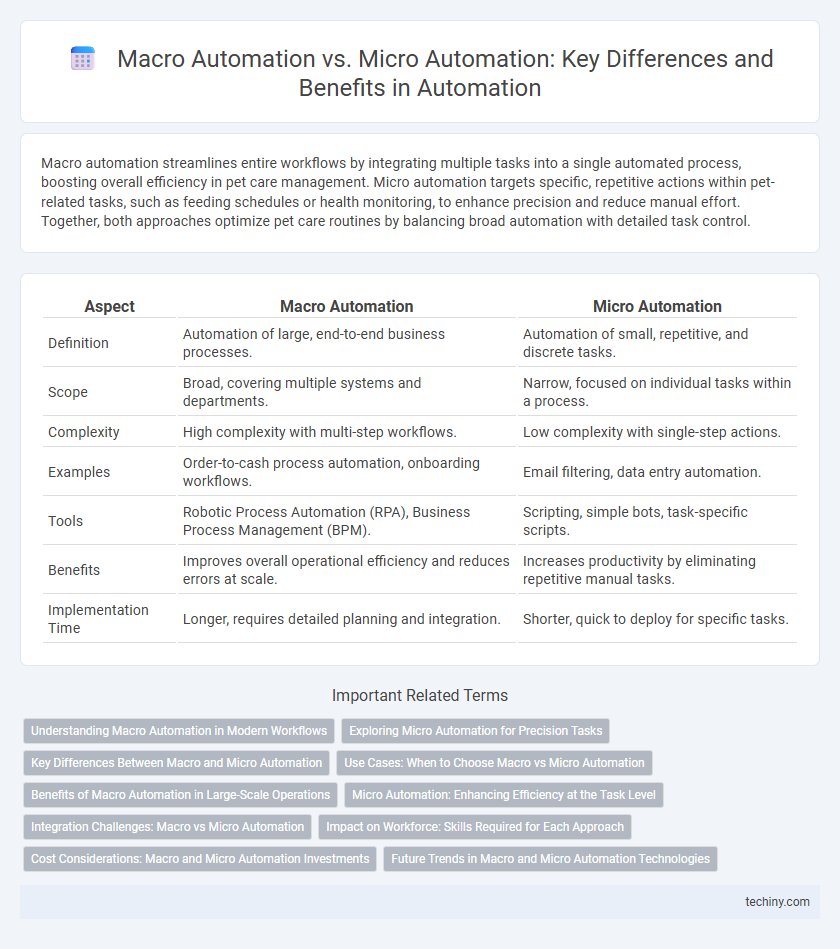Macro automation streamlines entire workflows by integrating multiple tasks into a single automated process, boosting overall efficiency in pet care management. Micro automation targets specific, repetitive actions within pet-related tasks, such as feeding schedules or health monitoring, to enhance precision and reduce manual effort. Together, both approaches optimize pet care routines by balancing broad automation with detailed task control.
Table of Comparison
| Aspect | Macro Automation | Micro Automation |
|---|---|---|
| Definition | Automation of large, end-to-end business processes. | Automation of small, repetitive, and discrete tasks. |
| Scope | Broad, covering multiple systems and departments. | Narrow, focused on individual tasks within a process. |
| Complexity | High complexity with multi-step workflows. | Low complexity with single-step actions. |
| Examples | Order-to-cash process automation, onboarding workflows. | Email filtering, data entry automation. |
| Tools | Robotic Process Automation (RPA), Business Process Management (BPM). | Scripting, simple bots, task-specific scripts. |
| Benefits | Improves overall operational efficiency and reduces errors at scale. | Increases productivity by eliminating repetitive manual tasks. |
| Implementation Time | Longer, requires detailed planning and integration. | Shorter, quick to deploy for specific tasks. |
Understanding Macro Automation in Modern Workflows
Macro automation streamlines entire business processes by automating large, complex workflows across multiple systems, significantly enhancing efficiency and reducing manual intervention. It integrates diverse applications and services to execute end-to-end tasks such as order processing, customer onboarding, and financial reporting with minimal human input. Understanding macro automation enables organizations to optimize resource allocation, improve scalability, and accelerate digital transformation initiatives.
Exploring Micro Automation for Precision Tasks
Micro Automation targets highly specific, repetitive tasks within broader workflows, enabling increased accuracy and efficiency through precise automation scripts or bots. Unlike Macro Automation, which handles end-to-end processes, Micro Automation excels in optimizing granular steps such as data entry validation or targeted notifications. Leveraging Micro Automation reduces errors and operational bottlenecks, particularly in industries requiring meticulous attention to detail, like healthcare and finance.
Key Differences Between Macro and Micro Automation
Macro automation involves automating large-scale, end-to-end processes across multiple systems, while micro automation focuses on automating specific, repetitive tasks within individual applications. Macro automation typically requires complex integrations and higher initial investment, whereas micro automation is easier to implement and offers quicker returns by streamlining discrete workflow components. Key differences also include scalability, with macro automation driving enterprise-wide efficiency and micro automation enhancing task-level productivity.
Use Cases: When to Choose Macro vs Micro Automation
Macro automation is ideal for large-scale processes involving multiple systems and complex workflows, such as end-to-end order processing or enterprise resource planning integration. Micro automation suits repetitive, granular tasks like data entry, email responses, or individual user interactions within a single application. Choosing between macro and micro automation depends on the scope and complexity of the task, where macro optimizes broad processes and micro enhances specific, high-frequency actions.
Benefits of Macro Automation in Large-Scale Operations
Macro automation enhances efficiency in large-scale operations by coordinating multiple complex tasks across various systems, reducing human error and operational costs. It enables scalability through centralized control and integration of workflows, facilitating faster decision-making and resource management. This broad approach improves overall productivity and consistency in processes spanning entire departments or organizations.
Micro Automation: Enhancing Efficiency at the Task Level
Micro Automation targets specific, repetitive tasks within workflows, significantly boosting operational efficiency by minimizing manual intervention. It streamlines processes at the granular level, enabling faster execution and reducing error rates compared to broader Macro Automation strategies. Integrating Micro Automation tools such as robotic process automation (RPA) and AI-driven scripts enhances accuracy and productivity in routine task management.
Integration Challenges: Macro vs Micro Automation
Macro automation faces integration challenges due to its reliance on large-scale systems and diverse enterprise applications, often requiring complex middleware and extensive customization to ensure seamless data flow. Micro automation, while more modular and easier to deploy, encounters difficulties in coordinating numerous small bots and maintaining consistency across multiple processes and platforms. Effective integration in both cases demands robust APIs and scalable orchestration tools to bridge disparate systems and reduce operational silos.
Impact on Workforce: Skills Required for Each Approach
Macro automation demands workforce skills in system integration, process design, and strategic oversight to manage large-scale automated workflows effectively. Micro automation requires employees to possess specialized technical abilities such as script writing, task-specific tool usage, and quick adaptation to iterative changes in individual processes. Both approaches necessitate continuous upskilling but differ in scope: macro automation emphasizes cross-functional coordination while micro automation focuses on detailed task execution proficiency.
Cost Considerations: Macro and Micro Automation Investments
Macro automation requires substantial initial capital investment due to complex infrastructure and large-scale integration, often suitable for enterprise-level operations. Micro automation involves lower upfront costs with focused deployment on specific tasks, enabling quicker ROI and scalability for smaller processes. Evaluating long-term maintenance and operational expenses is crucial as macro automation demands higher ongoing support compared to the relatively minimal costs of micro automation solutions.
Future Trends in Macro and Micro Automation Technologies
Future trends in macro and micro automation technologies include increased integration of artificial intelligence and machine learning to enhance process efficiency and decision-making accuracy. Macro automation will expand through large-scale robotic process automation (RPA) platforms optimizing enterprise-wide workflows, while micro automation will focus on more granular task automation using intelligent scripts and low-code tools. Emerging developments in edge computing and IoT will further drive micro automation by enabling real-time data processing and adaptive responses at the device level.
Macro Automation vs Micro Automation Infographic

 techiny.com
techiny.com